Not-designated cultural property
Work products held in National Museum of Korea
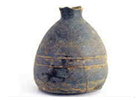
Earthen Bottle (Joseon Era) Discovered in Inchang-dong in 1966 (Founder: Shin Man-ok), Kept by National museum of Korea White porcelain bottle (Joseon Era) Discovered in Inchang-dong in 1966 (Founder: Shin Man-ok), Kept by National museum of Korea Stone candle holder Discovered in Inchang-dong in 1974 (Founder: Ko Kwang-soo), Kept by National museum of Korea
Boru Fortress of Goguryeo
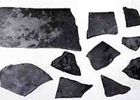
Earthen pieces collected as the Goguryeo relics around Jeongnip Hall
Goguryeo Relics I in Hongryeonbong
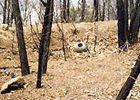
This is on the top area of the ridge on the southern part of Achasan site. There are two areas to fine the Goguryeo relics and they are relatively in good shape overall
Goguryeo Relics Ⅱ in Achasan
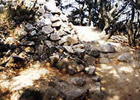
This is located on the peak of a small mountain at the point of 276m of elevation on the back of Daeseongam. The stone structure is remained in relatively fine condition
Yongmasan Ancient Tomb Site
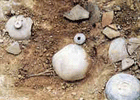
The Achasan area is located on the southern edge of Gwangju Mountains stretched out to northeast and southwest directions after splitting from the Cheolryeong area of the Taebaek Mountains. For the geomancy, Achasan is a mountain to make the northern mountain area into a great location along with Bukak, Gwanak, Gyeyang, and Gamaksan and it was once called as Namhaengsan. The area is located with the adjacent part of Gwangjin-gu and Jungrang-gu of Seoul with Guri City and is well suited for tomb site with the topography including the mountains of Achasan, Yongmasan, Bonghwasan and others along with the rivers of Jungrangcheon and Wangsukcheon in between. In addition, this area was the place with fierce battle by the Three Kingdom as they were growing to become a powerful state to gain this Hangang River basin. It was controlled by Baekje first, followed by the occupation of Goguryeo, eventually controlled by Silla. Therefore, this area is shown with the tombs of people from the Three Kingdom Era. Currently, there are approximately 70 tombs confirmed as destroyed in the Achasan area, and it would reach much more than 150 tomb sites including the ones not destroyed. The ancient tombs are mostly the stone tombs or stone chambered tombs. They dug the floor on weathered rock site with the piling up the stones of 20~30cm size for 7~8 layers to make the four walls with the clay laid on the floor with the flat stones of 5cm in thickness to place the table to have the corpse with the width of 60cm. The size is generally in 2.4m of length, 1.5m of width, and 1.1m of depth, and the direction is mainly south-north. There is no relic that is directly excavated from the ancient tomb site, but, there were many pieces of earthenware around the stone chambers of the tomb site that they help on understanding the characteristics of each era.
Achasan Ancient Tomb SiteⅠ
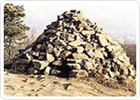
This is located on the peak of small mountain top on the east side of the main ridge of Achasan. It seems like the Goguryeo relic but Silla destroyed this area and built the ancient tomb site.
Achasan Ancient Tomb Site II
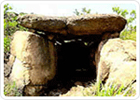
This is the horizontal-style stone tomb located in 125 m of elevation on the peak of rocky peak on the west of Uminae Village. This is a tomb that is very peculiar tomb not found in any other places.
Walking on Beolmal Bridge

Beolmal Bridge Stepping of Topyeong-dong was to prevent the flood damage of Hangang River with the reflection of farming area near to Hangang River in its folk play for fortune praying. This folk play was played around the full moon day of January in lunar calendar on the wooden bridge of Beolmal and stone island of Topyeong-dong and had been played up to 1916. Bridge Stepping Play began in Goryeo Era and all people in the village stayed all night to walk over the bridge for it would prevent misfortune for all year long. The Beolmal area in Topyeong-dong is located in the basin of Hangang River. The river overflows during summer for grave damages, and it had been suspended for approximately 80 years, and it was reproduced in 1993 by human cultural property Han Yo-seong (deceased) and his grandson, Han Cheol-soo, and currently, it is preserved by Guri Culture Center. Beolmal Bridge Stepping in ground play type is consisted of stage 1 with ground path play and ceremony for farming tools, stage 2 with stepping on ground god and well water raising, stage 3 with stepping on bridge and loosening of bridge, stage 4 with Gyeonggi Folk Song, and stage 5 with seokjeon and harmonious ground.
Daekgeyo Play
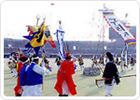
In between January first and the fifteenth day, a day is set and had the village people to come out and play, and it is the play "to take one day to set the date, one day to prepare, one day to play and one day to finish up." By making a high stage in broad square of the village, the play is on with the singing and dancing and the below the stage had the dancing boys in the 2~3 story high. Such a dancing boy group to dance is the "Daekgyeo Dance.” Men pretend like women in women’s attire and dance, play the drum and hoejeok to play the music. On one side, the tents are set to provide the nearby village people to serve with wine under the tents. This is a similar set with the Namsadang Group Play with the difference in having the village people to participate and play along. The Dongchang Village was large with many young people who sing well and dance well that Namsadang Group frequently came and played.